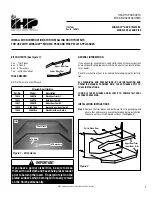
13
Figure 14. Typical Framing for a Raised Hearth - Detailed.
P
LANNING
Y
OUR
I
NSTALLATION
T
YPICAL
F
RAMING
- R
AISED
H
EARTH
:
Warning:
Failure to follow these guidelines may result in elevated operating temperatures,
an inability to remove or install the door, or install the optional fronts that are
available for this unit.
Figure 13. Typical Framing for a Raised Hearth - General.
A non-combustible Hearth
Insulation Board is required
(supplied) to be installed
between any non-combustible
hearth covering and any
combustible flooring beneath.
The design of the unit is such
that the fireplace must be
raised by the same distance as
any additional hearth covering
or riser that are added in front
of the fireplace.
Figure 14 shows a raised
hearth made of a wooden
construction hearth riser (B),
covered with the insulation
board provided and then
covered with non-combustible
slate (A). The thickness of
the riser (B) is 4” (102mm).
The thickness of the slate (A)
is 2” (52mm). A+B=C which
is 6” (152mm). In summary,
the fireplace must be raised
by the same thickness of any
material added in front of the
fireplace, with exception of the
1⁄2” (13mm) Hearth Insulation
Board that was provided with
the unit.
If the raised hearth is deeper
or wider than the Insulation
Board provided with the unit,
additional
non-combustible
materials such as Backer Board
(cement board) can be used to
build up to the same thickness
as the Insulation Board.
All header, ceiling or shelf
dimensions are measured from
the floor that the fireplace sits
on. Failure to maintain minimum
installation dimensions can
lead to elevated temperatures,
fire or personal injury.
Summary of Contents for DV48
Page 52: ...WIRING HARNESS 52 ...
Page 57: ...PARTS DIAGRAM 57 ...














































